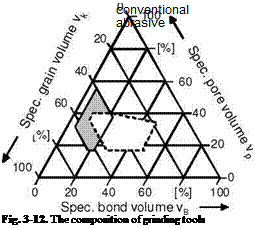The volumetric portion of grit VG, of bond VB and of pores VP of the total volume of the grinding component V is described by the equation
v = V* + v, + Vp (3.5)
If the individual columns are referred to the total volume V of the grinding component, we obtain the so-called structural formula. According to this
vK + vB + vp = 100%. (3.6)
Furthermore, from the grit mass me, the bond mass mB and the density of the abrasive grit pG and the bond pB, we obtain the relation
m — mK + mB — PKVK + PBVB. (3.7)
In relation to the total mass of the grinding component, we obtain m’K +m’B —100% . (3.8)
The possibilities resulting from volumetric changes are clarified in Fig. 3-11.
|
|
|
a) vk1 |
b) vk1 |
c) vk1+j |
d) vk1+j |
e) vk1+j1 |
|
vb1 |
vb1+j |
vb1 |
vb1-j |
vb1+j2 |
|
vp1 |
vp1-j |
vp1-j |
vp1 |
v(j1+y |
Volume : V = Vk+ Vb +Vp
100% = vk+ vb +vp
![]()
 |
|
m = mk + mb = PkVk + PbVb 100% = m’k + m’b
Fig. 3-11. The structure of grinding tools
Starting with a distribution of vG1, vB1, vP1, grinding component hardness can be improved in b) by increasing the bond volume by the amount j. If the grit quantity remains the same, the pore amount must be reduced to vP1-j. In c), the grit amount is raised at the cost of the pores, which must also lead to an increase in hardness, since the amount of bond remains the same and can thus form stronger webs. In d), there is an increase in vG and simultaneous reduction in vB. Diminished tool strength is here to be derived from the reduction of the bond crosssection [PEKL60a, PEKL66].
Finally, an increase in vG and vB by the respective amount j at the expense of the pore space is represented in e). In this way, the hardness of the grinding component may be raised considerably, but at the same time it diminishes its absorbing power for the chips produced, since the pore space must lead the chips away from the contact zone.
Such variation of volumetric parts has limits defined, on the one hand, by the strength requirements placed on the grinding component, on the other hand by tool manufacture.
 |
Fig. 3-12 shows a triple-material coordinate system, upon the axes of which are applied vG, vB and vP. The framed regions identify the compositional range of conventional grinding components.
|
Volume limits: |
|
|
conventional |
|
|
VKmax |
68 % |
|
VKmin _ |
40 % |
|
V = Bmax |
25 % |
|
VBmin = cBN |
5 % |
|
VKmax _ |
55 % |
|
VKmin = |
18 % |
|
VBmax _ |
48 % |
|
VBmin = |
10 % |
Beyond these limits, fabrication is only possible if special measures are taken, for example, hot pressing or adding burnout materials.

